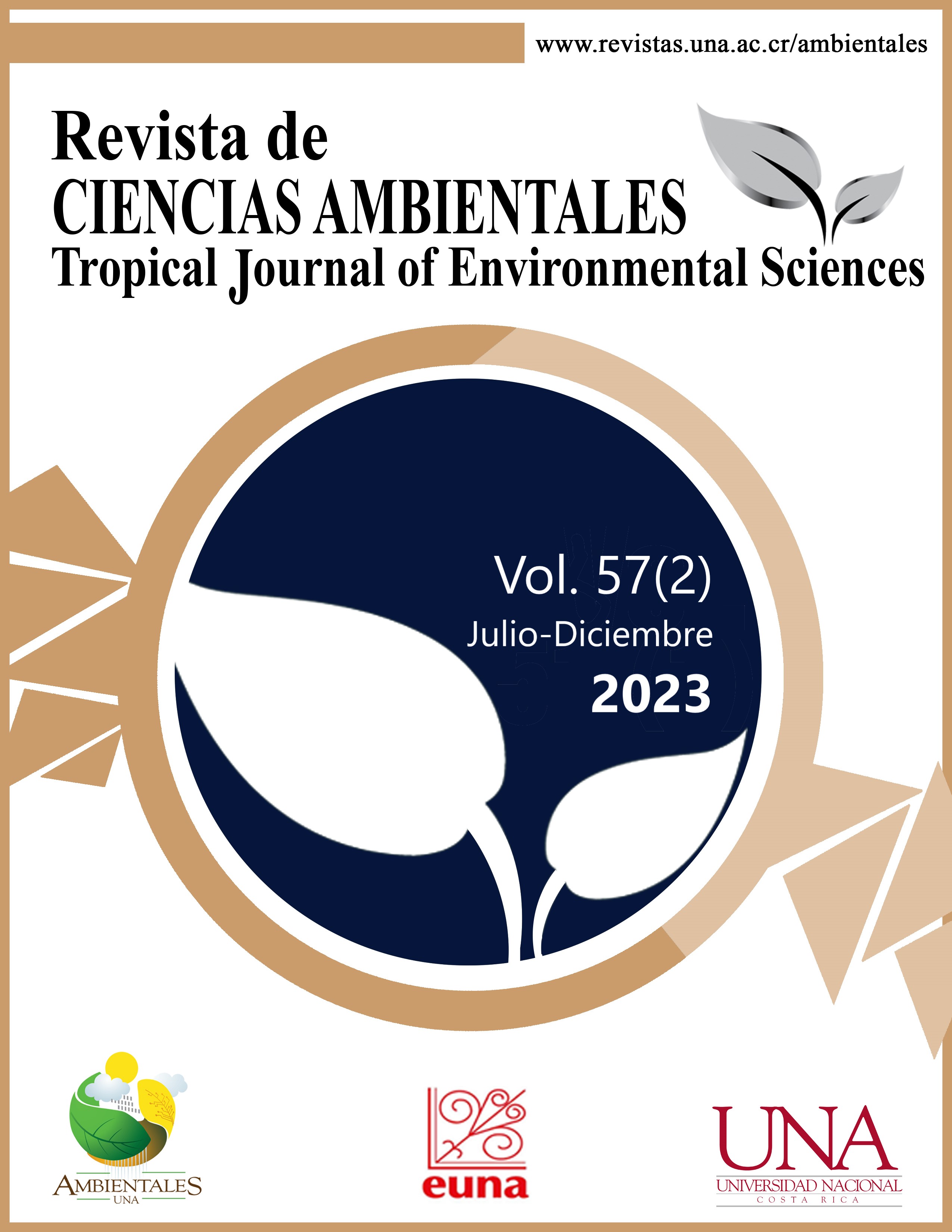Changes in the molecules of a light crude subjected to a soil weathering test to be applied in forensic geochemistry
DOI:
https://doi.org/10.15359/rca.57-2.8Keywords:
Methyldibenzothiophenes;, phytane;, pristane;, steranes;, terpanes.Abstract
[Introduction]: When an oil spill takes place in the soil, a weathering process begins that alters the composition of this resource and in advanced stages it can be unrecognizable with respect to the original hydrocarbon, making it difficult to assign responsibilities associated with contamination of this type. [Objective]: In the present work, the stability of n-alkanes, polycyclic aromatic hydrocarbons and aliphatic isoprenoids was analyzed in a light crude subjected to a soil weathering process under laboratory conditions for a period of one year, to be applied in litigation linked to oil spills and/or thefts. [Methodology]: Based on this, the profiles of the aforementioned molecules were analyzed by gas chromatography coupled to mass spectrometry from the crude fractions. [Results]: Next, specific parameters such as Pr/Ph (pristane/phytane), 4-MeDBT/1-MeDBT (methyldibenzothiophenes), and stigmastane C29αS/hopane C30 were calculated as diagnostic ratios that did not exceed 5 % of their relative standard deviation over the course of a year. On the other hand, the ratios Pr/n-C17 (pristane/heptadecane), Ph/n-C18 (phytane/octadecane), (n-C13 + n-C14)/(n-C25 + n-C26) and (N0 + N1)/N2 (N = naphthalenes) were the only ones with values above 5 %. [Conclusions]: These results, plus the analysis of the chromatograms obtained, suggest that both evaporation and biodegradation have altered the general composition of the crude, however, most of the isoprenoids remained unchanged under the test conditions throughout the study time period, which demonstrates their ability to solve the problems described.
References
Abdulazeez, T. & Fantke, P. (2017). Polycyclic aromatic hydrocarbons. A review. Cogent Environmental Science, 3(1). https://doi.org/10.1080/23311843.2017.1339841
Acuña, A. & Pucci G. (2022). Domestication of an indigenous bacterial consortium to remove hydrocarbons from soils of the Austral Basin. International Journal of Science and Research, 11(5), 1898-1903.
Aeppli, C., Carmichael, C., Nelson, R., Lemkau, K., Graham, W., Redmond, M., Valentine, D. & Reddy, C. (2012). Oil Weathering after the Deepwater Horizon Disaster Led to the Formation of Oxygenated Residues. Environmental Science & Technology, 46(16), 8799-8807. https://doi.org/10.1021/es3015138
Aislabie, J., Balks, M., Astori, N., Stevenson, G. & Symons, R. (1999). Polycyclic aromatic hydrocarbons in fuel-oil contaminated soils. Antarctica, 39(13), 0-2207. https://doi.org/10.1016/S0045-6535(99)00144-7
An, T., Chen, H., Zhan, H., Zhu, Z. & Berndtsson, R. (2005). Sorption kinetics of naphthalene and phenantrene in loess soils. Environmental Geochemistry, 47(4), 467–474. https://doi.org/10.1007/s00254-004-1163-4
Brakstad, O., Daling, P., Faksness, L., Almas, I., Vang, S., Syslak, L. & Leirvik, F. (2014). Depletion and biodegradation of hydrocarbons in dispersions and emulsions of the Macondo 252 oil generated in an oil-on-seawater mesocosm flume basin. Marine Pollution Bulletin, 84(1-2), 125-134. https://doi.org/10.1016/j.marpolbul.2014.05.027
Brown, J., Beckmann, D., Bruce, L., Cook, L. & Mudge, S. (2011). PAH depletion ratios document the rapid weathering and attenuation of PAHs in oil samples collected after the Deepwater Horizon. In: Proceedings of the 2011 international oil spill conference. Portland, Oregon. https://doi.org/10.7901/2169-3358-2011-1-336
Douglas, G., Bence, A., Prince, E., Roger, C., Mc Millen, S. & Butler, E. (1996). Environmental Stability of Selected Petroleum Hydrocarbon Source and Weathering Ratios. Environmental Science & Technology, 30(7), 2332- https://doi.org/10.1021/es950751e
Douglas, G., Hardenstine, J., Liu, B. & Uhler, A. (2012). Laboratory and field verification of a method to estimate the extent of petroleum biodegradation in soil. Environmental Science Technology, 46(15), 8279-8287. https://doi.org/10.1021/es203976a
Faboya, O., Sojinu, S., Sonibare, O., Falodun, O. & Liao, Z. (2016). Aliphatic biomarkers distribution in crude oil-impacted soils: An environmental pollution indicator. Environmental Forensics, 17(1), 27-35. https://doi.org/10.1080/15275922.2015.1091400
Fernández-Varela, R., Andrade, J., Muniategui, S. & Prada, D. (2010). Selecting a reduced suite of diagnostic ratios calculated between petroleum biomarkers and polycyclic aromatic hydrocarbons to characterize a set of crude oils. Journal of Chromatography A, 1217, 8279-8289. https://doi.org/10.1016/j.chroma.2010.10.043
Greenwood, P., Wibrow, S., Suman, J. & Tibbett, M. (2008). Sequential hydrocarbon biodegradation in a soil from arid coastal Australia treated with oil under laboratory-controlled conditions. Organic Geochemistry, 39(9), 0-1346. https://doi.org/10.1016/j.orggeochem.2008.05.005
Kao, N., Su, M., Fan, J. & Chung, Y. (2015). Identification and quantification of biomarkers and polycyclic aromatic hydrocarbons (PAHs) in an aged mixed contaminated site: from source to soil. Environmental Science and Pollution Research, 22(10), 7529-7546. https://doi.org/10.1007/s11356-015-4237-9
Kienhuis, P., Kraus, U. & Kooistra K. (2019). Oil identification. En: Encyclopedia of Analytical Science. (Worsfold P., Townshend A., Poole C. y Miro M. Eds.). UK: Academic Press, pp. 45-52.
López, L. y Infante C. (2021). Cambios en los biomarcadores de la fracción de hidrocarburos saturados en un ensayo de biorremediación con un crudo extrapesado. Revista Internacional de Contaminación Ambiental, 37, 119-131. https://doi.org/10.20937/RICA.53718
Mariano, A., Kataoka, A., Angelis, D. & Bonotto, D. (2007). Laboratory study on the bioremediation of diesel oil contaminated soil from a petrol station. Brazilian Journal of Microbiology, 38, 346-353. https://doi.org/10.1590/S1517-83822007000200030
Munoz, D., Guiliano, M., Doumenq, P., Jacquot, F., Scherrer, P. & Mille, G. (1997). Long-term evolution of petroleum biomarkers in mangrove soil (Guadeloupe). Marine Pollution Bulletin, 34(11), 868-874. https://doi.org/10.1016/S0025-326X(97)00061-1
Olson, G., Gao, H., Meyer, B., Miles, M. & Overton, E. (2017). Effect of Corexit 9500 A on Mississippi Canyon crude oil weathering patterns using artificial and natural seawater. Heliyon, 3(3), e00269. https://doi.org/10.1016/j.heliyon.2017.e00269
Peters, K., Walters, C. & Moldowan, J. (2005). The Biomarker Guide. Biomarkers and Isotopes in the Environment and Human History Reino Unido: Cambridge University Press.
Prince, R., Garrett, R., Bare, R., Grosman, M., Townsend, T., Suflita, J., Lee, K., Owens, E., Sergy, G., Braddock, J., Lindstrom, J. & Lessard, R. (2003). The roles of photooxidation and biodegradation in long-term weathering of crude and heavy fuel oils. Spill Science Technology Bulletin, 8, 145-156. https://doi.org/10.1016/S1353-2561(03)00017-3
Rosell-Melé, A., Moraleda-Cibrián, N., Cartró-Sabaté, M., Colomer-Ventura, F., Mayor, P. & Orta-Martínez, M. (2018). Oil pollution in soils and sediments from the Northern Peruvian Amazon. Science of The Total Environment, 1010-1019. https://doi.org/10.1016/j.scitotenv.2017.07.208
Seguel, C., Mudge, S., Salgado, C. & Toledo, M. (2001). Tracing sewage in the marine environment: Altered signatures in Concepcion Bay, Chile. Water Research, 17, 4166-4174. https://doi.org/10.1016/S0043-1354(01)00146-4
Service, C., Nelson, T., Paquet, P., Mclnes, W., Chris, T. & Service, C. (2012). Pipelines and parks: evaluating external risks to protected areas from the proposed Northern Gateway Oil Transport Project. Natural Areas Journal, 32, 367-376. https://doi.org/10.3375/043.032.0404
Sutton, P., Lewis, C. & Rowland, S. (2005). Isolation of individual hydrocarbons from the unresolved complex hydrocarbon mixture of a biodegraded crude oil using preparative capillary gas chromatography. Organic Geochemistry, 36, 963-970. https://doi.org/10.1016/j.orggeochem.2004.11.007
Toledo, S., Peri, P. & Fontenla, S. (2022). Environmental Conditions and Grazing Exerted Effects on Arbuscular Mycorrhizal in Plants at Southern Patagonia Rangelands. Rangeland Ecology & Management, 81, 44-54. https://doi.org/10.1016/j.rama.2021.11.005
Tomas, G. y Acuña, A. (2023). Estudio de biomarcadores del petróleo a partir de la meteorización de un crudo en agua de mar. Revista Internacional de Contaminación Ambiental, 39, 71-84. https://doi.org/10.20937/RICA.54799
Tomas, G. y Acuña, A. (2022). Biomarcadores aplicados al estudio de crudos extraídos de la Formación Magallanes, Cuenca Austral, Argentina. Boletín de la Sociedad Geológica Mexicana, 74(1), A160621. https://doi.org/10.18268/BSGM2022v74n1a160621
Wang, Z. & Fingas, M. (2003). Development of oil hydrocarbon fingerprinting and identification techniques. Marine Pollution Bulletin, 47(9-12), 423-452. https://doi.org/10.1016/S0025-326X(03)00215-7
Wang, Z., Stout, S. & Fingas, M. (2006). Forensic fingerprinting of biomarkers for oil spill characterization and source identification. Environmental Forensics, 7, 105-146. https://doi.org/10.1080/15275920600667104
Yavari, S., Malakahmad, A. & Sapari, N. (2015). A review on phytoremediation of crude oil spills. Water, Air, and Soil Pollution, 226(8). https://doi.org/10.1007/s11270-015-2550-z
Yim, U., Ha, S., An, J., Won, J., Han, G., Hong, S., Kim, M., Jung, J. & Shim, W. (2011). Fingerprint and weathering characteristics of stranded oils after the Hebei Spirit oil spill. Journal of Hazardous Materials, 197, 60-69. https://doi.org/10.1016/j.jhazmat.2011.09.055
Zhang, H., Yin, X., Zhou, H., Wang, J. & Han, L. (2015). Weathering Characteristics of Crude Oils from Dalian Oil Spill Accident, China. Aquatic Procedia, 3, 238-244. https://doi.org/10.1016/j.aqpro.2015.02.217
Published
How to Cite
Issue
Section
License

This work is licensed under a Creative Commons Attribution-NonCommercial-ShareAlike 4.0 International License.



















